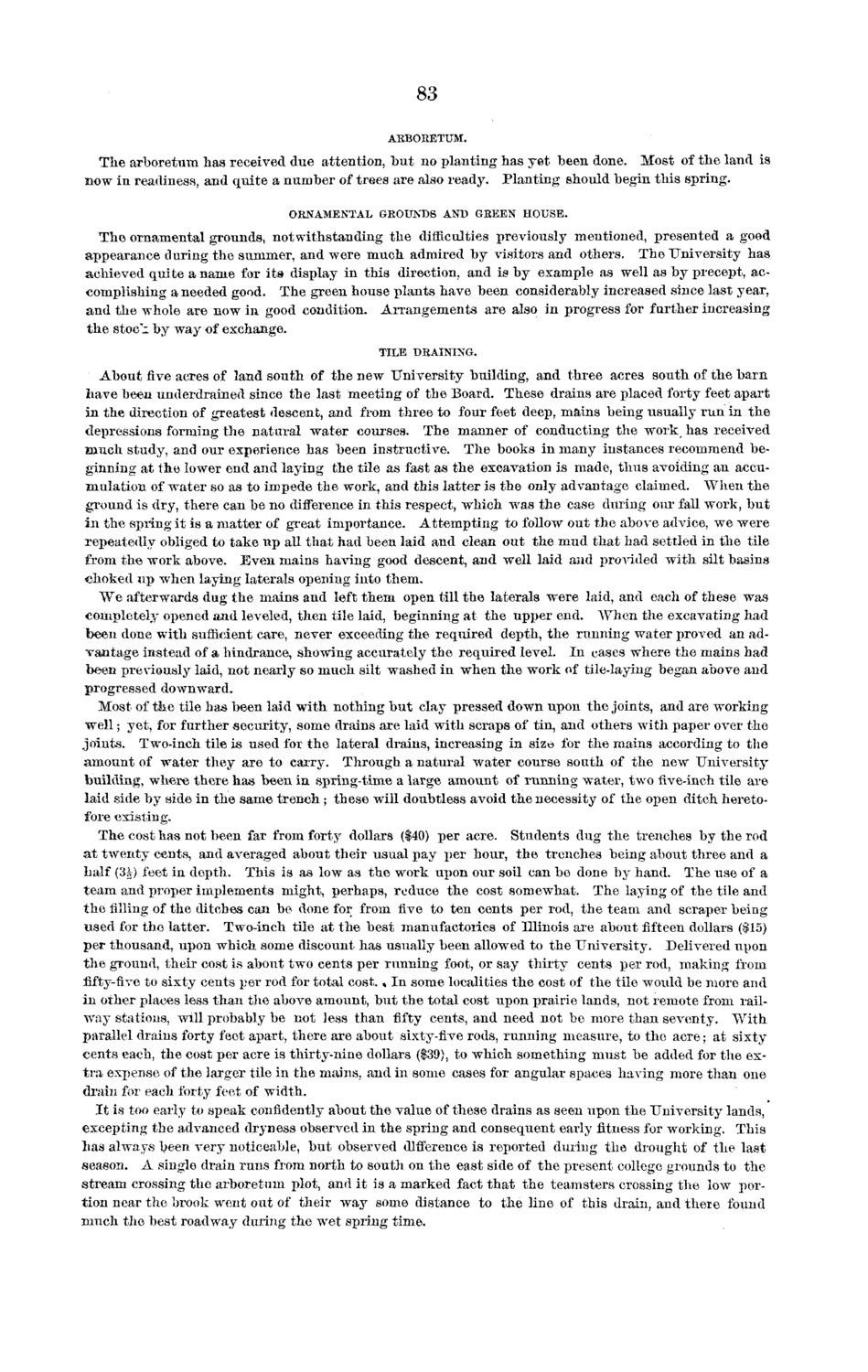| |
| |
Caption: Board of Trustees Minutes - 1872
This is a reduced-resolution page image for fast online browsing.

EXTRACTED TEXT FROM PAGE:
83 ARBORETUM. The arboretum has received due attention, but no planting has yet been done. Most of the land is now in readiness, and quite a number of trees are also ready. Planting should begin this spring. ORNAMENTAL GROUNDS AND GREEN HOUSE. The ornamental grounds, notwithstanding the difficulties previously mentioned, presented a good appearance during the summer, and were much admired by visitors and others. The University has achieved quite a name for ita display in this direction, and is by example as well as by precept, accomplishing a needed good. The green house plants have been considerably increased since last year, and the whole are now in good condition. Arrangements are also in progress for further increasing the stoc^: by way of exchange. TILE DRAINING. About five acres of land south of the new University building, and three acres south of the barn have been underdrained since the last meeting of the Board. These drains are placed forty feet apart in the direction of greatest descent, and from three to four feet deep, mains being usually run in the depressions forming the natural water courses. The manner of conducting the work has received much study, and our experience has been instructive. The books in many instances recommend beginning at the lower end and laying the tile as fast as the excavation is made, thus avoiding an accumulation of water so as to impede the work, and this latter is the only advantage claimed. When the ground is dry, there can be no difference in this respect, which was the case during our fall work, but in the spring it is a matter of great importance. Attempting to follow out the above advice, we were repeatedly obliged to take up all that had been laid and clean out the mud that had settled in the tile from the work above. Even mains having good descent, and well laid and provided with silt basins choked up when laying laterals opening into them. We afterwards dug the mains and left them open till the laterals were laid, and each of these was completely opened and leveled, then tile laid, beginning at the upper end. When the excavating had been done with sufficient care, never exceeding the required depth, the running water proved an advantage instead of a hindrance, showing accurately the required level. In cases where the mains had been previously laid, not nearly so much silt washed in when the work of tile-laying began above and progressed downward. Most of the tile has been laid with nothing but clay pressed down upon the joints, and are working well; yet, for further security, some drains are laid with scraps of tin, and others with paper over the joints. Two-inch tile is used for the lateral drains, increasing in size for the mains according to the amount of water they are to carry. Through a natural water course south of the new University building, where there has been in spring-time a large amount of running water, two five-inch tile are laid side by side in the same trench; these will doubtless avoid the necessity of the open ditch heretofore existing. The cost has not been far from forty dollars ($40) per acre. Students dug the trenches by the rod at twenty cents, and averaged about their usual pay per hour, the trenches being about three and a half (3|) feet in depth. This is as low as the work upon our soil can be done by hand. The use of a team and proper implements might, perhaps, reduce the cost somewhat. The laying of the tile and the filling of the ditches can be done for from five to ten cents per rod, the team and scraper being used for the latter. Two-inch tile at the best manufactories of Illinois are about fifteen dollars (#15) per thousand, upon which some discount has usually been allowed to the University. Delivered upon the ground, their cost is about two cents per running foot, or say thirty cents per rod, making from fifty-five to sixty cents per rod for total cost., In some localities the cost of the tile would be more and in other places less than the above amount, but the total cost upon prairie lands, not remote from railway stations, will probably be not less than fifty cents, and need not be more than seventy. With parallel drains forty feet apart, there are about sixty-five rods, running measure, to the acre; at sixty cents each, the cost per acre is thirty-nine dollars ($39), to which something must be added for the extra expense of the larger tile in the mains, and in some cases for angular spaces having more than one drain for each forty feet of width. I t is too early to speak confidently about the value of these drains as seen upon the University lands, excepting the advanced dryness observed in the spring and consequent early fitness for working. This has always been very noticeable, but observed difference is reported during the drought of the last season. A single drain runs from north to south on the east side of the present college grounds to the stream crossing the arboretum plot, and it is a marked fact that the teamsters crossing the low portion near the brook went out of their way some distance to the line of this drain, and there found much the best roadway during the wet spring time.
| |